A Technology Manager’s Guide to InfoComm 2023

As I sit down to write this blog, InfoComm is only a few weeks away. I am very excited to see the energy, excitement and turnout at InfoComm 2023, which I expect to be the first back-to-normal InfoComm in three years.
Coincidentally, for those of us in higher education, this time of the year is also one of our busiest. We are dealing with faculty and staff who are looking to spend money that may be left in their current budget (sales). We are putting together plans and designs for summer refreshes (design and integration). We are starting to upgrade and perform maintenance on classrooms (installation). We are supporting the myriad events that take place at the end of an academic year (live event support). That’s right, higher ed technology managers actually span the entire realm of the AV industry. That is why they need to attend InfoComm to continue to grow professionally and support their campus and students with excellent service.
One of the struggles I had for the first couple of years when attending InfoComm was how to make the best of it. In my first year, I only attended for the show floor. Basically, I wandered around aimlessly for three days, not really knowing what to do. Fortunately, that does not need to be the case for you, whether this is your first or 15th show.
To make the most of your InfoComm experience, the first thing you need to do is make a plan. While InfoComm does have tools to build a calendar, I am an “on paper” person so I usually take out a daily calendar and fill it in that way. I find this easier to look at for planning and use the InfoComm tools when I am actually at the show.
I suggest that you start that plan with the training you want to take part in. AVIXA does an excellent job of providing information on its website leading up to the show. Click on the education tab to be brought to the wide variety of options. Spend some time looking through these courses and select the ones that you want to attend. As a higher ed attendee, be sure to pay attention to the “Learning Space” track. Many of these sessions will double as a training session and as a networking session for you. Considering that we are no different than a full integration/live events company, though, make sure you look for workshops and sessions that have to do with whatever challenge or problem you currently are trying to solve. While all the tracks are pertinent to higher ed, the Live Events, Streaming, Design and Integration, Business and Project Management and the Conferencing and Collaboration are especially relevant.
Next, think about networking time. Higher Ed is particularly good at sharing with each other and learning from each other. You MUST stop by the HETMA booth for at least a half hour each day to meet and greet your colleagues. Your network will grow exponentially when you do this. A tip from someone who has wandered the show floor, plan your visit to the HETMA booth after a walk around the floor. You will appreciate the opportunity to give your feet a rest. If you are on social media, watch for the various “tweet ups” that occur at the show as well. My experience is that the people who attend these are very welcoming to everyone, even people they have never met.
Counterintuitively, I think the show floor is what you plan last. It is counterintuitive, especially for first-timers, because that is what they think of when they think of InfoComm. However, I say consider it last for a couple of reasons. First, the show floor is open for set hours and all the vendors will be there for the entire time. You don’t need to plan around them. Second, no matter how much time you spend there, you will miss things on the show floor. It is unavoidable. That is why you use tools like rAVe’s reporting and videos to catch up on what you miss. As previously mentioned, the InfoComm website is excellent and it already has a map of vendors and booth locations. Take a list of the vendors you want to see, then take a look at the map and plan out your path. You don’t want to be wandering around, and you don’t want to ping pong back and forth between booths that are on opposite sides of the center. You do want to leave some time open on the time you have planned for the floor. This will allow you to poke your head into some of the smaller booths of manufacturers of which you have never heard. These are where you will find some magical solutions that you never knew existed. Additionally, this non-planned floor time will give you the opportunity to spend half an hour or so on Wednesday and Thursday night to look at the rAVe site and see what was reported on that interests you, and then stick that on your next day’s schedule.
A few last thoughts. InfoComm is huge and the convention center is shockingly large. Do not plan back-to-back events! It is not uncommon or unexpected for it to take you 15 minutes or more to get from one meeting room to another, or one side of the convention center to another. Recognize in advance that you will leave feeling like you have missed some things because you will miss things. This is where having multiple people from your organization attend is important. You can make plans together so that someone gets to everything they need to see. Reach out to your reps and get invited to the free meals and evening events. These are great opportunities to network, and a great way to lower the cost of attendance. I know some tech managers who spend their entire time at InfoComm without dropping a dime on food. Finally, plan some downtime when you return. You will be physically and mentally exhausted and need to spend time with friends and family and enjoy a few days of summer break before you get right into using everything you have learned.




